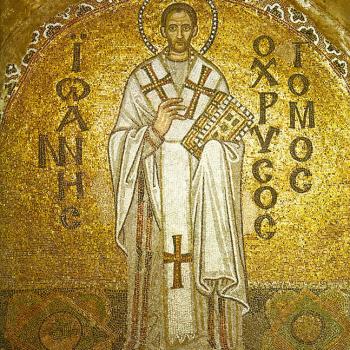Editors' Note: This article is part of the Patheos Public Square on Sacrifice: Religions and the Role of the Scapegoat. Read other perspectives here.
Truth about Christ's atoning work has changed over the millennia. What follows then, is a sampling of different theories about the atonement, concluding with the response of C. S. Lewis to these historical alterations. Lewis seems an apt guide, since one of the earliest theories about the atonement is called the Ransom Theory, inspiring the name Lewis chose for the protagonist of his "space trilogy": Elwin Ransom.
The Ransom Theory, which dates back to the second century, considered Christ a "ransom" paid to Satan who had kidnapped humanity. In order to free humanity from Satan's prison of sin, God sent Jesus as a payment — much as people send money to kidnappers in movies today. Gleeful about the payment, Satan arranges for Christ's death, only to discover that God has tricked him when Jesus rises from the dead.
Disturbed by the idea of God as a bait-and-switch trickster, Anselm of Canterbury (1033-1109) advocated a theory of atonement that emphasized, instead, God's honor. Rather than focus on Satan, Anselm established that humans chose sin over obedience to their Creator, and thus dishonored their Lord. However, unlike an earthly lord in Anselm's day, who would seek restitution from his serfs if they were to disobey and thus dishonor him, God's righteous honor cannot possibly be rectified by any human action. Only God in human form can satisfy transcendent standards of honor. This, then, became known as the Satisfaction Theory of atonement.
Four hundred years later, advocates of the Protestant Reformation updated Anselm's theory by replacing the medieval idea of honor, based on notions of fealty to a feudal lord, with the more culturally relevant concept of moral law. Because humans break God's law, they deserve to die. God, however, sent Jesus to take punishment in their place, so that a sinless human pays the price rather than sinful humanity. Known as Penal Substitution, this theory is often associated with John Calvin (1509-64), who reflects his training in criminal law when he writes that Christ was "made a substitute and a surety in the place of transgressors and even submitted as a criminal, to sustain and suffer all the punishment which would have been inflicted on them."
In the midst of all these theories, Peter Abelard (1079-1142) offered a perspective that avoids the idea of economic exchange driving most of the others. As we have seen, the Ransom Theory has God making a payment to Satan; in the Satisfaction Theory, Christ pays the necessary price to satisfy God's honor; in the Penal Substitution Theory, Christ pays the debt for human sin. In contrast, Abelard regards Christ's sacrifice on the cross not as a payment but as a gift: the gift of salvation. Furthermore, and just as importantly, the sacrificial love of Jesus influences humans to make gifts of themselves not only to God, but also to a hurting world.
Called the Moral Influence Theory, Abelard's view of the atonement echoed along various corridors of modern theology. Twentieth-century demythologizers, having internalized the anti-supernatural assumptions of 18th-century Enlightenment thinkers and 19th-century Higher Critics, reduce the atonement to moral influence alone. In this view, Jesus, though not one with God, perfectly exemplified the sacrificial love humanity was meant to embody. Rudolf Bultmann (1884-1976), for example, saw the crucifixion as modeling "victory over inauthentic existence and unbelief." Similarly, Paul Tillich (1886-1965) held that Christ's martyrdom symbolizes how we might conquer "existential forces which threaten to deprive us of authentic existence."
Aiming for a much broader view of existence — a view that allows for the supernatural — some current theologians combine Abelard's Moral Influence with a paradigm suggested by Swedish bishop Gustaf Aulén in his 1931 book Christus Victor. Rather than endorsing a bait-and-switch game with the devil (as in the traditional Ransom Theory), or making God subservient to honor or the moral law (as in Satisfaction and Penal Substitution Theories), Aulén argues that Christ achieved victory over evil not through his death but through the resurrection (hence Christus Victor).
Combining Aulén's endorsement of a supernatural resurrection with Abelard's advocacy of Moral Influence, theologians have developed, with the help of literary scholar René Girard, what is known as Non-Violent Atonement Theory: an approach that defies the violence — both physical and rhetorical — that warps multiple religions today. Rather than argue that God put Jesus to death to pay the price for sin, which implies that God endorses violent measures, Non-Violent Atonement emphasizes that human sin put Jesus to death. However, God conquered human sin through the resurrection (Christus Victor), Christ's loving sacrifice influencing all who accept his gift (Moral Influence).




